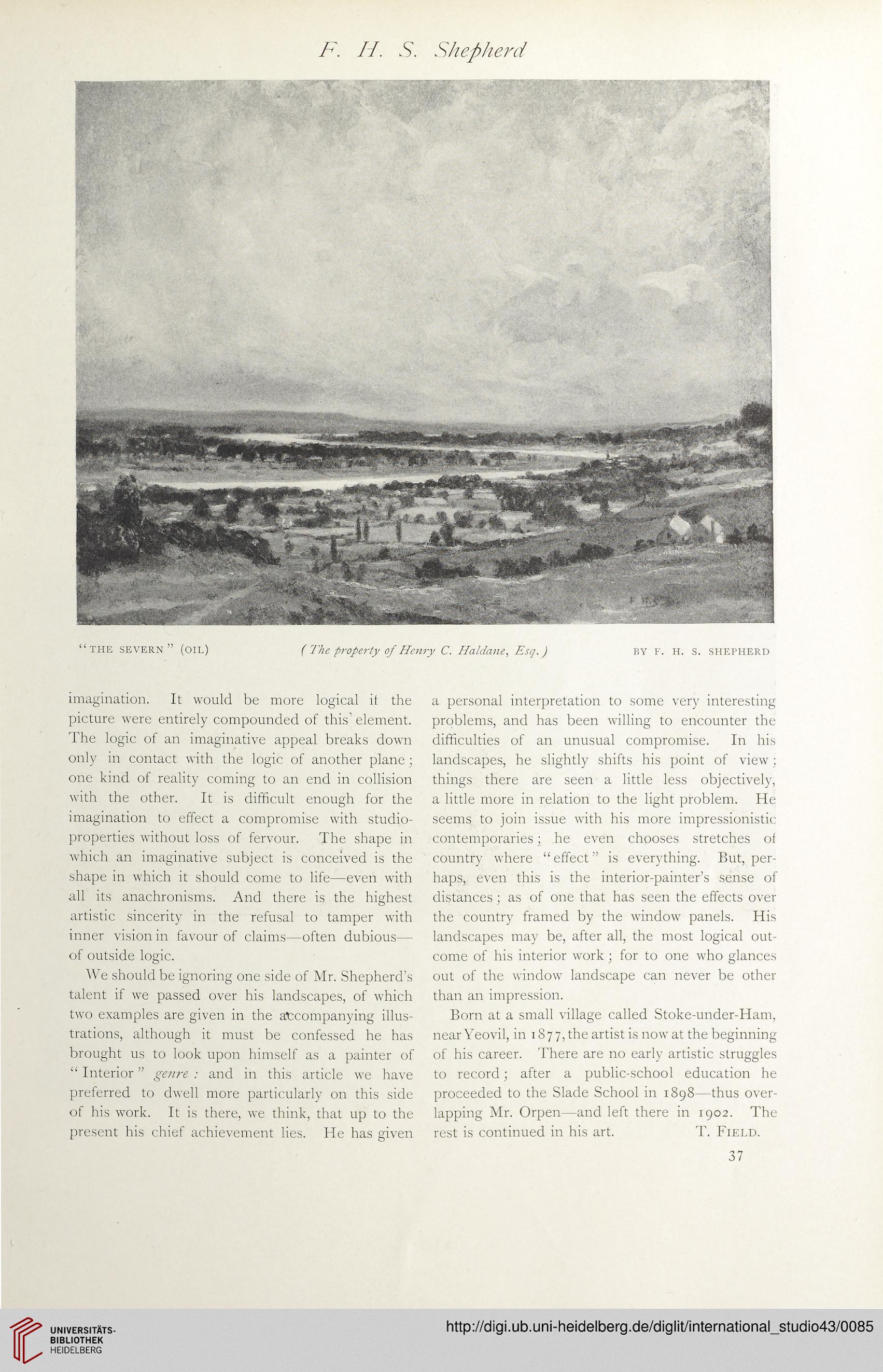F. H. S. Shepherd
“THE SEVERN ” (OIL)
( The property of Henry C. Haldane, Esq.)
BY F. H. S. SHEPHERD
imagination. It would be more logical it the
picture were entirely compounded of this' element.
The logic of an imaginative appeal breaks down
only in contact with the logic of another plane;
one kind of reality coming to an end in collision
with the other. It is difficult enough for the
imagination to effect a compromise with studio-
properties without loss of fervour. The shape in
which an imaginative subject is conceived is the
shape in which it should come to life—even with
all its anachronisms. And there is the highest
artistic sincerity in the refusal to tamper with
inner vision in favour of claims—often dubious—
of outside logic.
We should be ignoring one side of Mr. Shepherd’s
talent if we passed over his landscapes, of which
two examples are given in the accompanying illus-
trations, although it must be confessed he has
brought us to look upon himself as a painter of
“ Interior ” genre : and in this article we have
preferred to dwell more particularly on this side
of his work. It is there, we think, that up to the
present his chief achievement lies. He has given
a personal interpretation to some very interesting
problems, and has been willing to encounter the
difficulties of an unusual compromise. In his
landscapes, he slightly shifts his point of view;
things there are seen a little less objectively,
a little more in relation to the light problem. He
seems to join issue with his more impressionistic
contemporaries; he even chooses stretches of
country where “effect” is everything. But, per-
haps, even this is the interior-painter’s sense of
distances; as of one that has seen the effects over
the country framed by the window panels. His
landscapes may be, after all, the most logical out-
come of his interior work; for to one who glances
out of the window landscape can never be other
than an impression.
Born at a small village called Stoke-under-Ham,
near Yeovil, in 1877, the artist is now at the beginning
of his career. There are no early artistic struggles
to record; after a public-school education he
proceeded to the Slade School in 1898—thus over-
lapping Mr. Orpen—and left there in 1902. The
rest is continued in his art. T. Field.
37
“THE SEVERN ” (OIL)
( The property of Henry C. Haldane, Esq.)
BY F. H. S. SHEPHERD
imagination. It would be more logical it the
picture were entirely compounded of this' element.
The logic of an imaginative appeal breaks down
only in contact with the logic of another plane;
one kind of reality coming to an end in collision
with the other. It is difficult enough for the
imagination to effect a compromise with studio-
properties without loss of fervour. The shape in
which an imaginative subject is conceived is the
shape in which it should come to life—even with
all its anachronisms. And there is the highest
artistic sincerity in the refusal to tamper with
inner vision in favour of claims—often dubious—
of outside logic.
We should be ignoring one side of Mr. Shepherd’s
talent if we passed over his landscapes, of which
two examples are given in the accompanying illus-
trations, although it must be confessed he has
brought us to look upon himself as a painter of
“ Interior ” genre : and in this article we have
preferred to dwell more particularly on this side
of his work. It is there, we think, that up to the
present his chief achievement lies. He has given
a personal interpretation to some very interesting
problems, and has been willing to encounter the
difficulties of an unusual compromise. In his
landscapes, he slightly shifts his point of view;
things there are seen a little less objectively,
a little more in relation to the light problem. He
seems to join issue with his more impressionistic
contemporaries; he even chooses stretches of
country where “effect” is everything. But, per-
haps, even this is the interior-painter’s sense of
distances; as of one that has seen the effects over
the country framed by the window panels. His
landscapes may be, after all, the most logical out-
come of his interior work; for to one who glances
out of the window landscape can never be other
than an impression.
Born at a small village called Stoke-under-Ham,
near Yeovil, in 1877, the artist is now at the beginning
of his career. There are no early artistic struggles
to record; after a public-school education he
proceeded to the Slade School in 1898—thus over-
lapping Mr. Orpen—and left there in 1902. The
rest is continued in his art. T. Field.
37




